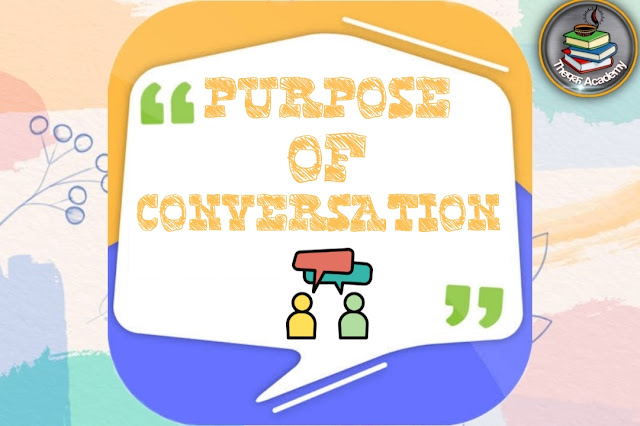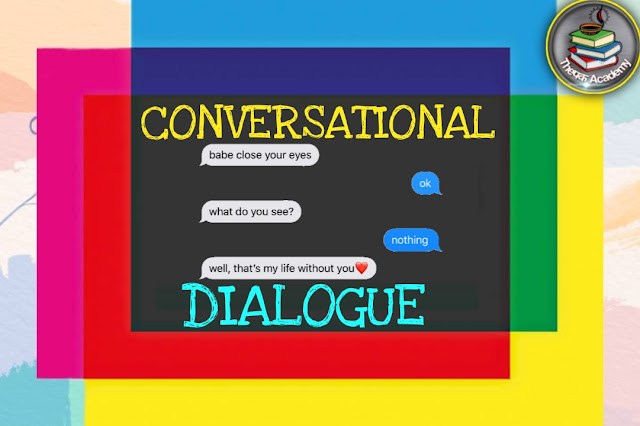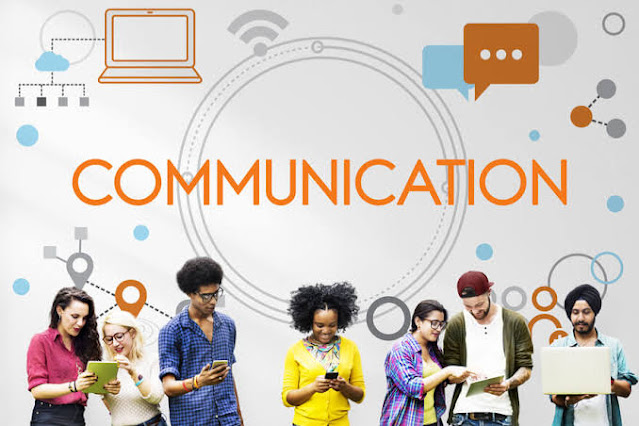Q.:- What is the purpose of Monologue?
OR
What do you know about Dialogue?
Ans.:-
Introduction:-
Talking is a part of our daily routine. We talk to our friends, relatives and others on general or specific matters. We present our views and listen to theirs. But sometimes we speak and the other(s) listen to us without giving some response, or vice versa. Sometimes we simply converse with each other and sometimes discuss specific matter(s). They are termed as monologue, conversation and dialogue respectively. They can take place for formal as well as informal purpose. We shall discuss all the situations one by one.
Monologue:-
The word monologue has its roots in the Greek word monologos meaning "speaking alone". It is a speech delivered by one person, or a long one-sided conversation. The speaker does all the speaking and no other person gets involved in the conversation. S/he performs all the function of speaking without expecting or getting feedback. It is a one-sided affair and non-interactive in nature. Though the listener(s) remains present during the course of action, listens to the speaker, interprets the meaning, but does not respond.
A monologue speaks at people, not with people. Many plays and shows involving performers begin with a single character giving a monologue to the audience before the plot or action starts. You would have found a stand-up comedian giving monologue in the beginning of a comedy show. It is not necessary that a monologue can be delivered only in the beginning, but can occur all of the time.
Monologues are frequently used in plays, films, poetry and novels. They are presented to express character's inner feelings or mental thoughts. When a character addresses to another character(s) or the audience to reveal character's inner feelings or thoughts, it is known as dramatic monologue. It can also be internal, where the character talks to oneself in order to understand character's dilemma. It is called 'interior monologue. It is spoken out loud. It is sometimes used to advance the action.
Many-a-times we read a story or a poem and fail to understand what the character is thinking about. Monologue helps us to understand his/her thoughts clearly. When a character speaks in a monologue, audience can read character's mind, and understand what motivates that character. Shakespeare has skillfully used monologues in many of his plays to portray the feeling and thinking of his characters. We find the example of monologue in famous balcony scene of his play “Romeo and Juliet”. Romeo reveals his thoughts to the audience through the monologue.
Conversation:-
Conversation is the talking between two or more individuals. It is an interactive process which involves the speaker(s) and the listener(s). Both the speaker and the listener interact and reciprocate in the process. It employs informal exchange of views, ideas and information through spoken words. It connects people to make social interaction possible. It helps to establish, maintain, improve and consolidate social as well as professional relations.
Purpose:-
Conversation can take place to meet the following objectives:
(a) Interaction: Conversation is a social activity. We spend time with people whom we like and whose company we find stimulating. Whenever we find an opportunity to interact, we share our thoughts with them. We converse with them and try to get acknowledged. Interaction is the first and foremost aim of conversation. This is the driving force behind our social activities.
(b) Self-expression: We have some ideas and thoughts in our mind. We need to express them to get acknowledged. We communicate them through conversation. Self-expression is the other purpose of conversation.
(c) To know others: Self-expression is not the sole purpose of social interaction, rather knowing others' feelings and thinking is equally important. Conversation helps to understand others' views, ideas, feelings and thoughts. This is another purpose of conversation.
(d) To build trust: Mutual trust is essential in social as well as professional life. We cannot pour our heart before others. We need to establish our trust through our interaction. Building trust is another purpose of conversation.
(e) To carry-out various activities: We are social being and need others' help to carry out certain activities. Conversation helps to perform these activities in a better way.
Types:-
Conversations are interactional and transactional in nature. The type depends on the relationship between the participants. The first type of casual conversation occurs between the participants who are socially and culturally close to each other; and the second occurs between the participants who are less intimate. The type also depends on the situation. On that basis, the conversations can be divided into the following two categories:
- Informal
- Formal
(a) Informal Conversation-
This type of conversation is held in informal setting. It occurs when the participants have close and intimate relations. It involves the exchange of personal information, such as gossiping, general inquires, personal matters, etc.
This type of conversation is different from informal conversation in content, style, language and approach. It occurs between the participants who are less intimate to each other or have formal relations. It takes place in semi- formal or formal setting. It involves the exchange of words in a formal manner. It may include the conversation with a shopkeeper, officer, professional, or so.
Example:-
A Conversation among the principal and Teachers
(Two teachers enter the Principal's room)
Teacher : Good morning sir!
Principal : Good morning, Mr. Aggarwal! And how're you Ms. Anuradha?
Mr. Aggarwal : Sir, I have come to ask about the admission process this year.
Principal : I have no information about the date when it may start. I have written to the university, but the response is still awaited.
Mr. Aggarwal : But we are to plan the things.
Principal : I do understand. But we should be ready and make necessary arrangements. Of course it may start in the last week of June.
Ways of Delivery:-
- Face-to-face
- Over telephone
(a) Face-to-face Conversation-
Abhishek : Sneha, I like this restaurant very much. How's the place?
Sneha : Lovely! Very nice!
Abhishek : I was sure that you'd like the place. I usually visit this restaurant. Let's sit in that corner, shall we?
Sneha : Yes!
Abhishek : waiter! Waiter!
Waiter : Good morning sir. I'm very sorry to trouble you, but I wonder if you could possibly move to another table. I'm afraid to this table is reserved.
Abhishek : Oh yes, why not.
(b) Telephonic Conversation-
Example:-
A Conversation between Two Friends
Amit : (over the phone) Am I taking to Aditi?
Aditi : (Recieving the call) Yes. Who's there?
Amit : Hi, Aditi. I'm Amit. How're you?
Aditi : I'm fine. How about you?
Amit : Are you coming to the college today?
Aditi : Yes! What happened?
Amit : Could you please bring the notes of yesterday's class with you. I didn't attend the class.
Dialogue:-
Objectives-
- To bring two parties closer to each other.
- To dispel misunderstanding.
- To create a climate of mutual trust.
- To build relationships.
- To make participants more sympathetic towards one another, in spite of their differences.
- To prepare ground for negotiation.
- To facilitate decision-making.
Types of Dialogue:-
(a) Conversational Dialogue-
(b) Enquiry-
(c) Negotiation-
Tips to be a Good Conversationalist-
(a) Be an active listener: A good conversationalist should be a good listener. S/he should listen to the other participant(s) carefully and attentively. S/he should listen and understand the meaning of the conveyed message. S/he should not interrupt in between and let him/her complete the statement. Then s/he should present his/her views in a forceful manner.
(b) Be a smart speaker: A good conversationalist should be a smart speaker. S/he should not speak whatever comes to her/his mind. S/he should think before speaking. S/he should evaluate the consequences of her/his statement. S/he should use an appropriate style to present her/his views.
(c) Be interested: A good conversationalist should be interested in the conversation. Her/his action, attitude and behaviour should reflect the interest. S/he should make active participation. Some conversationalists remain lifeless during conversation.They remain mere passive listener and do not contribute anything to the conversation. It shows that the person is not interested, and should be avoided.
(d) Be clear: A good conversationalist should be clear in thoughts as well as expression.S/he should present his/her views in clear and simple words. Words having double meaning should be avoided. The words should be used with proper intonation, pauses, to make the meaning clear.
(e) Be polite: Politeness is the key to an effective conversation. The conversationalist should present her/his views politely. S/he should be courteous and respect the other participant's views. If disagrees, s/he should express her/his disagreement or reservation in a friendly way. S/he should not be rude and impolite. S/he should avoid making the remark(s) that can hurt the other person. S/he should not jump to hasty conclusion.
(f) Be positive: The conversationalist should remain positive during the conversation. S/he should avoid criticizing others. S/he should appreciate the good and positive qualities of the other participant(s) and express her/his appreciation.
(g) Be flexible: The conversationalist should not be rigid. S/he should be flexible in approach, style and attitude. S/he should accept the right point(s) of the other person. S/he should not argue for argument's sake and avoid heated argument.
(h) Use proper body movements: Body movements make communication effective and forceful. The conversationalist should use body movements wherever required. S/he should maintain eye-contact with the other participant(s). It adds to the confidence and reflects person's liveliness.
Thanking you for read my blog 😁😁

































3 comments
Nice 👍👍
ReplyDeleteGood topic collection Deepak Academy👍👍👍👍👌
ReplyDeleteNice words
ReplyDelete